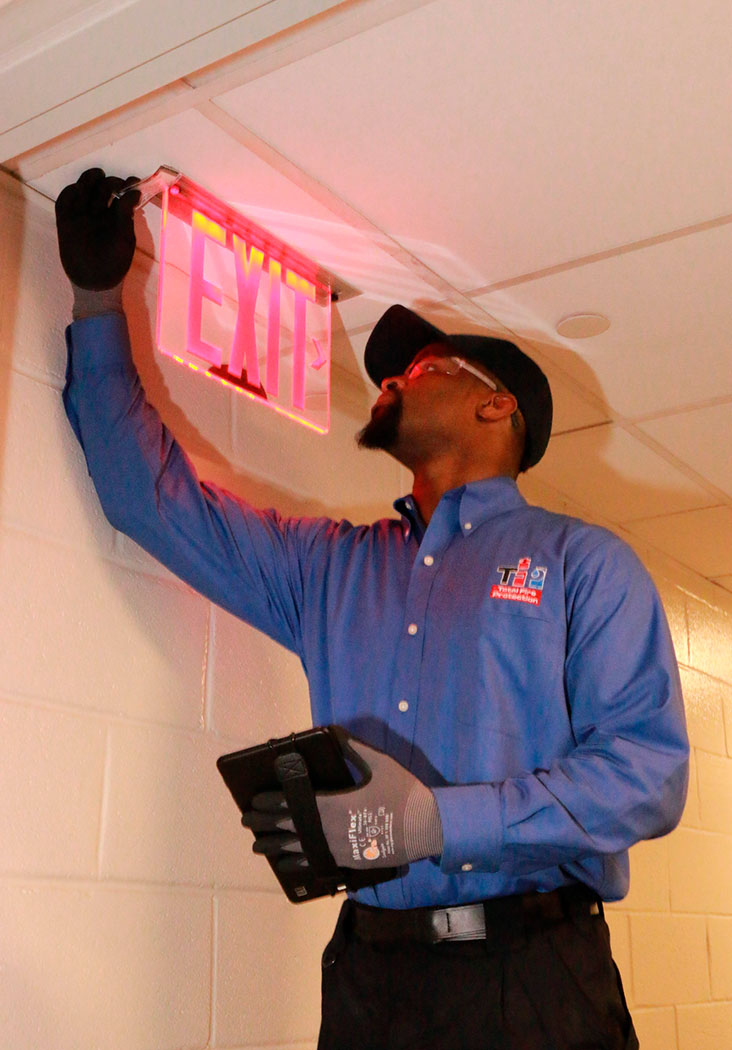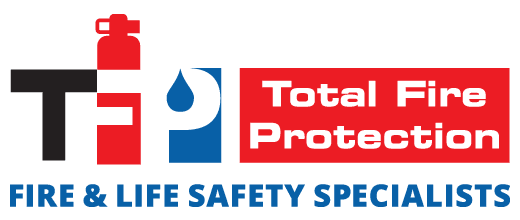A power outage within a commercial, institutional, or public building transforms the built environment into a vulnerable space, where compromised visibility and disrupted systems heighten the urgency for immediate, coordinated safety measures. Without visibility, even familiar spaces can become disorienting and dangerous. Elevators shut down, alarms may lose power, and densely occupied areas are plunged into darkness. In these moments, emergency lighting during outages becomes one of the most critical safeguards in the built environment. It offers a visual lifeline to guide people to safety and reduce chaos.
Thousands of facilities across New York City and the Tri-State area rely on expertly designed, installed, and maintained safety lighting systems provided by Total Fire Protection. Our certified technicians ensure that all systems meet OSHA, NFPA 101, and local AHJ regulations, providing not just code compliance but operational readiness under real-world emergency conditions.
The Role of Emergency Lighting in Power Outage Fire Safety
During a power failure, whether triggered by utility disruption, fire suppression activity, or extreme weather, the rapid loss of lighting creates disorientation and heightens physical risk throughout the facility. Without a reliable lighting infrastructure in place, building occupants may struggle to locate exits, interpret emergency signage, or navigate stairs and corridors, particularly under stress. Emergency lighting mitigates this risk by sustaining visibility for at least 90 minutes, providing critical time for safe and coordinated evacuation.
To comply with life safety codes and ensure effective occupant protection, backup lighting systems are legally required in:

- Exit corridors and stairwells
These vertical and horizontal passageways are the primary evacuation routes during emergencies. Emergency lighting ensures they remain passable and clearly defined, even in multi-story buildings or smoke-filled environments. - Areas surrounding emergency exits
Adequate lighting near egress doors allows occupants to identify exit pathways without hesitation. This includes lighting both the door itself and any adjoining signage or floor markings. - Fire alarm and suppression panels
Illuminating alarm interfaces, control panels, and manual pull stations is essential for emergency personnel and trained staff to assess system status, trigger alarms, or engage fire response protocols in low-light conditions. - Spaces identified in a building’s fire safety plan
These may include refuge areas, assembly zones, or shelter-in-place locations that require continuous visibility during emergencies for both occupants and first responders. - High-occupancy areas such as lobbies, cafeterias, and auditoriums
In dense gathering spaces, emergency lighting reduces the risk of crowd panic, improves movement flow, and facilitates communication during evacuation or lockdown procedures.
In healthcare facilities, research labs, and mission-critical infrastructure, emergency lighting ensures continued visibility in areas that must remain operational during outages, such as operating rooms, data centers, and control stations, where uninterrupted access to equipment is essential for life safety and continuity. Beyond simply providing temporary illumination, these systems facilitate organized evacuation, support emergency personnel, and preserve situational awareness, serving as a cornerstone of both occupant protection and overall building resilience.
Why Inadequate Lighting Poses a Serious Threat
Insufficient or non-functional emergency lighting creates a cascade of hazards that undermine both immediate occupant safety and long-term operational credibility. In the absence of proper illumination, even a well-rehearsed evacuation plan can break down under pressure. Trip-and-fall incidents, stalled movement, and failure to recognize exit signage are all common outcomes when visibility fails, particularly in multi-story or high-occupancy environments.
Even minor lapses in coverage can trigger significant repercussions, including:
- Delayed response times for building occupants and first responders
Critical seconds are lost when occupants cannot navigate to exits or when emergency personnel are forced to operate in obscured conditions without clearly illuminated reference points. - Violations during inspections or AHJ walk-throughs
Inspectors routinely cite emergency lighting as a deficiency, particularly in transitional spaces like stairwells, mechanical rooms, or basement corridors where fixtures are often overlooked. - Legal exposure following an incident
In the event of injury or loss during a power failure, lack of code-compliant lighting can be a decisive factor in liability claims or insurance disputes. - Denial or delay in obtaining Certificates of Occupancy
Emergency lighting failures are among the most common reasons for withheld approvals during construction closeouts or occupancy transitions. - Non-compliance with local and national fire safety codes
Failure to meet OSHA, NFPA, and jurisdiction-specific lighting requirements can result in financial penalties, forced remediation, or in severe cases, building closure orders.
In regions like New York City, where facility density, vertical design, and regulatory oversight are all elevated, these outcomes are not speculative. They are actively cited and enforced by AHJs with broad authority to issue violations or halt operations. Maintaining compliant emergency lighting is not only a legal obligation but a critical layer of protection that reinforces a facility’s overall safety posture.
Building a Reliable Backup Lighting System
An effective emergency lighting system integrates code-mandated and performance-critical components to ensure reliability in demanding conditions. It must be designed for both compliance and resilience, capable of functioning where visibility and power may be compromised. Each system should align with the facility’s unique risk profile. At Total Fire Protection, we implement lighting solutions that meet rigorous safety standards while supporting the operational needs of modern buildings. These systems typically include:

Code-Compliant Fixtures
TFP provides sleek, code-compliant signage and lighting fixtures suited for various facility types, including commercial buildings, hospitals, and entertainment venues. Our solutions are designed to remain visible and durable in a range of conditions, including smoke, humidity, and high traffic.
Battery Backup and Load Capacity
All emergency lights must function independently of the main power grid. Our team performs 90-minute battery load testing to ensure full performance under stress conditions. We maintain a complete inventory of batteries and parts, allowing for quick replacements and minimal disruption.
Photoluminescent Lighting Enhancements
In stairwells and corridors, photoluminescent lighting strips and egress signage provide critical redundancy. These non-electrical elements absorb and emit light in low-visibility environments, enhancing safe navigation alongside powered systems.
Centralized Control and Documentation
From automatic testing to annual inspections, TFP’s services include log test books, annual inspection stickers, and detailed reporting to keep your systems audit-ready. Our safety teams are trained to identify gaps, replace obsolete signage, and confirm the presence and operability of all required lighting components.
Best Practices for Maintaining Emergency Lighting During Outages
Installing code-compliant lighting is only the foundation. To ensure emergency lighting systems function reliably during real-world outages, consistent testing, inspection, and documentation are essential. Without a structured approach, even a properly installed system can become a point of failure when visibility is needed most. Total Fire Protection recommends the following maintenance practices, each aligned with NFPA 101 standards and AHJ expectations:

Monthly Functional Tests
These brief, scheduled tests verify that emergency lights activate properly and remain illuminated without interruption. They also serve as an early detection method for battery fatigue, corrosion, or electrical faults, enabling proactive maintenance before issues escalate.
Annual Full-Load Battery Tests
Mandated by NFPA 101, this 90-minute simulation replicates outage conditions to confirm that all emergency lighting remains fully functional throughout the required runtime. TFP technicians also ensure that battery units are appropriately installed, environmentally protected, and that expired batteries are disposed of in compliance with local hazardous waste protocols.
Obstruction-Free Illumination
Even properly installed fixtures can become ineffective if blocked or obstructed. TFP conducts detailed field surveys to confirm that lighting paths remain clear, and that new furnishings, construction, or signage have not impaired line-of-sight or light dispersion, especially in stairwells, corridors, and access-controlled areas.
Professional Surveys and Upgrades
Lighting needs evolve as buildings are renovated, repurposed, or expanded. TFP provides expert site surveys and system reviews to ensure lighting layouts remain aligned with your building’s current configuration and occupancy patterns. We also offer custom signage solutions that maintain aesthetic continuity while meeting the most current safety regulations.
Expert Support from Total Fire Protection
Total Fire Protection’s certified technicians bring deep expertise in the design, installation, and maintenance of emergency lighting systems for complex urban and commercial facilities. Our team handles every aspect of compliance, from photoluminescent and electrical lighting integration to documentation and coordination with Authorities Having Jurisdiction (AHJs). We ensure every component, from fixtures and backup systems to signage and inspection records, meets the most current NFPA, OSHA, and local code requirements.
Whether you’re preparing for an inspection, upgrading outdated systems, or commissioning a new facility, TFP provides responsive, end-to-end service across New York City and the Tri-State area. Our work ensures your emergency lighting is not only code-compliant but also fully operational when it matters most.
